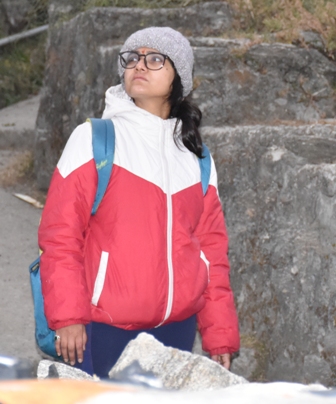As a researcher, I always dreamed of going on a field visit. Last Year, I got an unexpected opportunity to visit Joshimath with a team from Bath Spa University and our institute. In this blog post, I will share my experience of this magical journey.
Going for field visit was my dream since the first day I joined the institute. The story behind this field visit is somewhat magical for me. The journey to Joshimath started on 19-09-2022 when our institute celebrated the Post MoU with Bath Spa University, England. I was fortunate to be invited to this celebration, where I was also asked to join the team for the visit to katarmal sun temple. Little did I know that this visit would lead to an even bigger opportunity. While I was at the temple, I received a call from Dr. J.C. Kuniyal (Scientist G, Head, CEA &CC), who asked me if I would like to join a team of researchers for a field visit to Joshimath. Without any hesitation, I accepted the invitation and joined the team, which included Dr. Richard Johnson & Dr. Cerry Davis, (Bath Spa University) and Dr. J.C. Kuniyal, Dr. Kapil Kesarwani & Ms. Nidhi Kanwar from our institute.
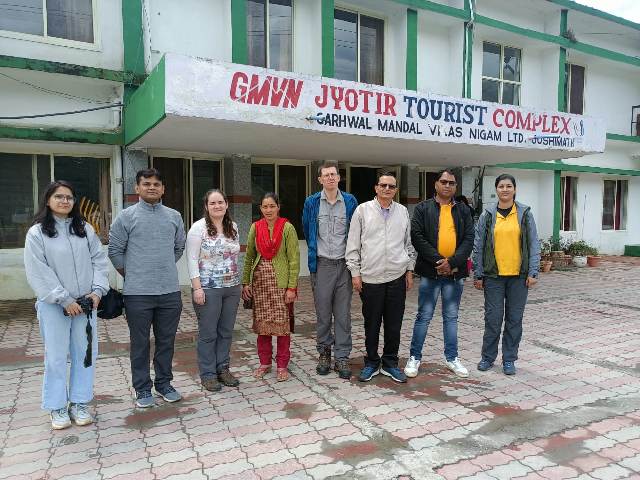 Meeting & Interaction session with Pradhan of Raini Village, Joshimath
Meeting & Interaction session with Pradhan of Raini Village, Joshimath
Next day on September 20, 2022 we headed for our field visit to Joshimath and the journey to Joshimath was long and tiring, but the beautiful scenery along the way made it worthwhile. As we reached our destination, I was awestruck by the majestic mountains and the beautiful valley. The research plan was to conduct the study, which involved collecting data on the climate and geography of the area. During our stay in Joshimath, we were also required to interact with the local people and learn about their culture and way of life. I was amazed by their resilience and adaptability to the harsh climate and terrain of the region.
On September 21, 2022 we started our work by visiting Raini and Tapovan villages, we did survey of the area and interacted with the villagers about their experiences regarding the previous disasters. Dr. Richard, who didn't speak Hindi, impressed me with his endearing habit of taking notes after every session with the villagers. He was not only taking notes but also using translator to understand and grasp every bit of information that he could get from the interaction. Working with people of such calibre is always a great opportunity to learn and grow.
On September 22, 2022 we visited the Lata and mana villages. The magnificent mountains that were visible from there were so huge that they made me feel so humble and so tiny, not in a bad way but you get the zest of it. When you see those huge mountains, you feel like what kind of ego you have that makes you feel you are something, you are nothing look at these mountains they are huge and you are just like an ant in front of them. With the feeling of gratitude, we started our work and had meeting with the villagers from mana and Lata village. They were so welcoming that we didn’t feel that we don’t belong here for a minute. We saw their traditional house in Lata. We bought apples and walnut from them and they were so happy that we did.
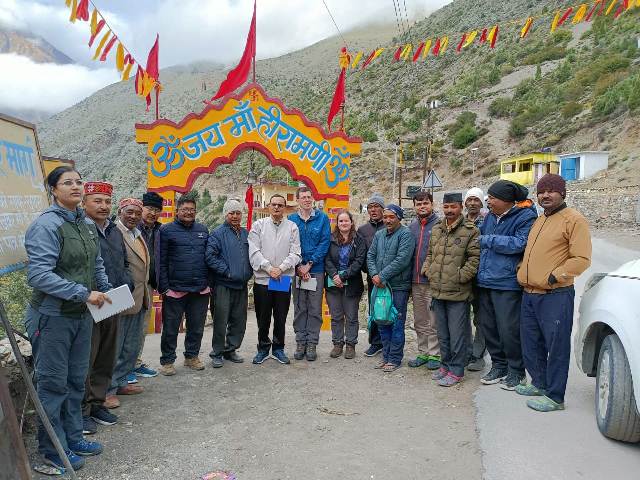 Meeting & Interaction with people of Mana Village
Meeting & Interaction with people of Mana Village
Apart from our research challenge that I felt that villagers of Lata are suffering was that they did not have any proper transportation for the fruits and dry fruits that they grow. Sometimes in migratory season they tend to left all the apples to rot there only because they don’t have any means to transport them to market. There were also some other challenges for the community like medical facility. An old lady saw me and asked about the medicine Some researchers might have promised them that they will get medicine for them but I guess they didn’t.
On the fourth day of the field tour, after finishing the survey we visited Narsingh temple It is believed that once the arm of Lord Narsingh will break at that time the Nar-Narayan parvat (mountain) will collapse and road to badrinath will be blocked and it will be shifted to bhavishya badri. It felt so surreal to visit the temple it made me feel blessed. I also saw the Hathiparvat, a mountain shaped like a sitting elephant, which reminded me of the creative beauty of our mother earth. During our survey, we noticed cracks that foreshadowed the present crisis in Joshimath, where the land is subsiding and buildings have severe cracks.
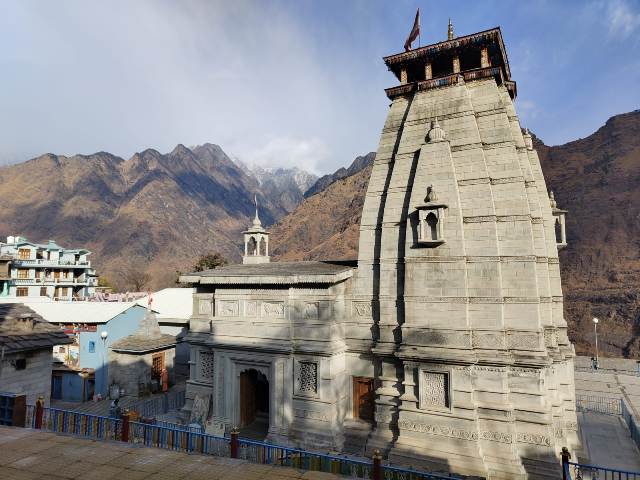 Narsingh Temple, Joshimath
Narsingh Temple, Joshimath
During the survey we were trying to figure out the past climate disasters that could have occurred in the region. The study may help to predict the future scenario of the region. At that time, we saw some cracks that took shape of the present crisis in Joshimath. I was told that Joshimath is sinking and land is slowly subsiding. At present time we all saw how it became so massive that many buildings have severe cracks and thousands of people have to be shifted. After my first visit I again got the opportunity to visit the disaster hit Joshimath. This time around January 2023 (with team of 10 members from HQs and team from Srinagar Regional centre), I felt sad this time since I saw fear and helplessness in the eyes of people that were affected due to the land subsidence. Kalp Vrisksh: Tree Planted by Adishankracharya in Manohar baghr area of Joshimath
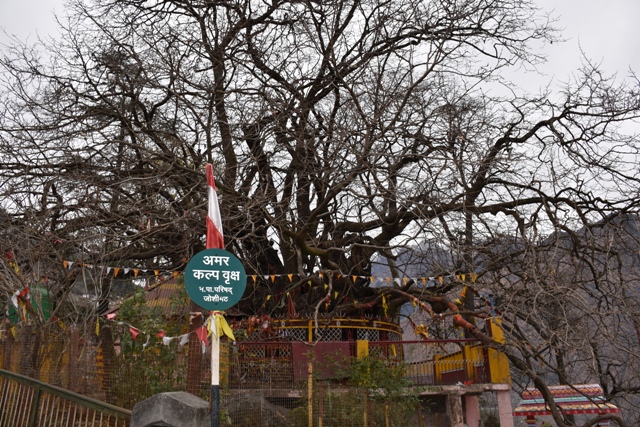 Kalp Vrisksh: Tree Planted by Adishankracharya in Manohar baghr area of Joshimath
Kalp Vrisksh: Tree Planted by Adishankracharya in Manohar baghr area of Joshimath
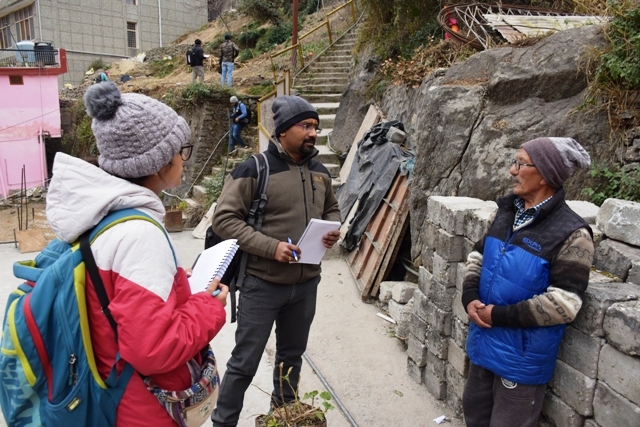 Interaction with locals of Joshimath
Interaction with locals of Joshimath
Although I am not the right person to share the detail findings of the study that were conducted but I would like to share the effect of the whole scenario on people. I met with many people all of them beside blaming this destruction on one or other reasons, were helpless. I met an old man whom till day I can’t forget, his name was Mr. Narayan Singh he was somewhat 80 years old and he asked me mam what are you doing I told him I am doing survey of the houses that were affected and I am a student, he asked please come and see my house. When we reached inside, her wife cried and said he is more than 80-year-old and we were surviving on the rent from the houses but due to the situation everyone left and we don’t have any income now. The old man used charcoal that is used to build road to bind the stairs and base of his house. He was just smiling helplessly; his smile had some crimpling kind of pain that pierced through my heart.
 Homestay in Subahi Village, Joshimath
Homestay in Subahi Village, Joshimath
This is only one story and I came across at least 100 of such stories in and around Joshimath. It just made me feel the importance of sustainable development and why before any development project to consider the benefit of community is so important and necessary. And by development it doesn’t mean only for big projects, it pertains any development as small as house construction. We must focus on sustainability at our level also. To leave everything behind and start all over again is not possible for everyone, young people may start over they have their whole life but what about the old people who gave up all their savings to settle down but now everything is somewhat lost. This case should be taken as a lesson to be more peculiar about the outcomes and cost of development in fragile and pristine mountains.
 Road leading to Bhavishya Badri
Road leading to Bhavishya Badri
 Bhavishya Badri temple
Bhavishya Badri temple
Despite the emotional toll of these visits, I have come to love field visits for the exposure and opportunities. Field visit provides you a way out from the monotonous routine. Though I love doing my work but sometimes it gets monotonous. Such visits come like a breeze of fresh air and at least for me I can say that they motivate to do work harder and better. Although I always wanted to visit the glaciers to do my core research but with time the visits that involves survey doesn’t seem so weird to me. There is always something to learn, being an introvert, I tend to talk less with people that I don’t know but this provided me with the confidence to talk to strangers and much needed exposure. I hope one day I would share my first glacier field visit.
Conclusion:
The field visit to Joshimath was a dream come true for me. It was an opportunity to learn, explore, and connect with nature and people. I am grateful to my institute and the team for giving me this opportunity, and I look forward to many more such experiences in the future.
